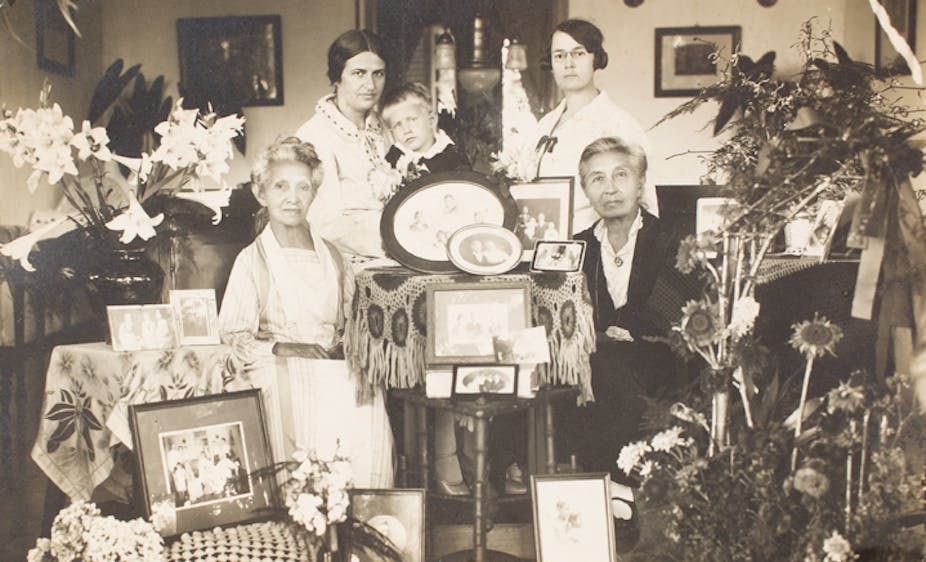Say “Indonesia” today and what visual associations does the word prompt? For many Australians, an ambivalent mix of pleasant and troubled images, no doubt.
But a new photography exhibition at the National Gallery of Australia (NGA) – of photography from Indonesia between the 1850s and 1940s – will add a layer of complexity to those associations.
When we mention Indonesia today some people will think of landscapes of leisure on Bali: tropical beach and mountain resorts, ancient Hindu temples, exotic markets. The same island evokes nightmare memories of recent events the news media transformed into national tragedies: scenes of beachside tourist haunts wrecked by the terrorist bombings of 2002 and 2005, and the human drama of the trial and incarceration of Australians caught trafficking drugs through Denpasar airport.
Add to that images of natural disaster (tsunami victims on devastated Acehnese coastlines in 2004, volcanic ash covering towns and airports in Java just recently), and political catastrophes (Acehnese, Papuan, and Timorese freedom fighters brutalised by central government forces in rebel provinces).
The list of tense and tragic images we’ve seen in the Australian media is endless, and seems to link Indonesia to all the trouble in the world, an association heightened under the present Coalition government by diplomatic spats over espionage in Indonesia and Australia’s conduct in handling asylum seekers travelling via Indonesia on leaky boats.
On Wednesday February 26 the Australian Foreign Minister, Julie Bishop, has a break from the recent treadmill of fraught diplomacy with Indonesia to open a show that encourages a fresh look at the archipelago, past and present.
The NGA’s Garden of the East exhibition showcases the largest collection of studio and amateur photographs from pre-independence Indonesia in the southern hemisphere, acquired in 2007 and on display for the first time.

It combines a stunning selection of photographs taken by the leading studio photographers of 19th and early 20th-century Indonesia – Woodbury and Page, Isidore van Kinsbergen, Thilly Weissenborn, Kassian Cephas, to mention a few – with a significant collection of photographs taken by amateur and “family” practitioners.
Together, the photographs invite reflection on the continuities and changes in how Western as well as Indonesian photographers have seen Indonesia, now and a century ago.
Unlike today, 19th and early 20th-century images of Indonesia rarely showed controversial or openly critical views of what was going on in the archipelago. Given that Indonesia was not a political democracy when the photographs in the exhibition were taken (it was formally under Dutch colonial rule until 1949), and varieties of press censorship were in place, it wasn’t possible for contemporary photographers to show mainstream audiences the dark side of colonial Indonesian life – war, atrocity, labour exploitation, political strife.

Photographs do exist that document these aspects of Indonesia’s past, but they were usually taken for surveillance and intelligence purposes by men who worked for colonial authorities (the military and police, prison, factory and plantation bosses).
Yet Garden of the East provides intriguing views of pre-independence Indonesia, some of which will resonate in surprising ways with contemporary audiences.
The photographs reveal how things that still appeal to tourists today have remained largely unchanged for a century: dramatic tropical landscapes, ancient Hindu-Buddhist monuments, exotic indigenous people, and splendid royal traditions.

The exhibition also speaks to people familiar with the juxtaposition of rich and poor, antique and modern, local and international that characterises parts of Indonesia: already a hundred years ago, advanced industries operated in the countryside (especially around sugar plantations), and electric trams, motor cars and grand buildings mixed with horse-drawn carts and wooden slums in large cities like Jakarta.

Perhaps the greatest revelation of the exhibition is the large number of fascinating amateur photographs, including family photo albums, that show the nature of daily life in Indonesia as seen by ordinary people rather than professional photographers.
They show the 1920s and 1930s – a period of revived interest among contemporary film and museum audiences – as it looked in Asia, replete with fashionably dressed men and women and art deco buildings. They show a then emerging middle class of Indonesians studying, driving shiny cars, and touring their “nation” (a novel concept for an archipelago only recently united under Dutch rule).
They reveal the complex profile of the colonial elite: not so much “European” as “Indo-European” – families of mixed Asian and European descent, a legacy of centuries of Dutch colonialism that reveals a long, intimate history of contact between Indonesia and the west (see the banner photo, above).
The photographs in Garden of the East many not show the whole story of Indonesia’s not-so-distant past, but they do provide views of the archipelago – as gorgeous, intriguing, contradictory and complicated – that inspire more critical reflection than the often one-dimensional images we often see now. And that’s a more replete way to look at Indonesia.
_Garden of the East: Photography in Indonesia 1850s–1940s is on show at the National Gallery of Australia, Canberra, from February 21 to June 22.

